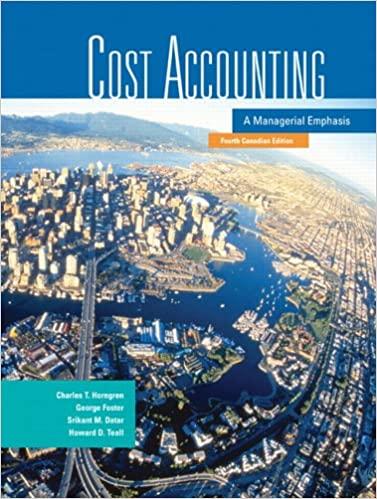/Process further or sell, joint cost allocation. (R. Capettini) Henley Company produces three /joint products, A, B,...
Question:
/Process further or sell, joint cost allocation. (R. Capettini) Henley Company produces three
/joint products, A, B, and C, from a single joint process with a fixed cost of $6,000 and a variable
/ cost of$2.40 per input unit. Each product can be either processed further or, at the splitoffpoint,
/ it (1) can be sold or (2) must be disposed of at a cost. Out of each input unit, Henley Company
/ produces 1 unit ofA, 3 units of B, and 2 units ofC. Selling and administrative costs are $16,800.
Required 1. Given the table below, for each product, should Henley Company process the product further or dispose of it (or sell it) at the splitoff point if Henley Company inputs 5,000 units? Show, for each product, how much better off Henley would be if it followed your advice versus making the alternative decision. Assume that if Henley does not further process a product, it does not incur any of the further processing costs.
Product Selling Price per Unit at Splitoff Point Cost per Unit to Dispose of Product at SplitoffPoint Further Processing Costs Selling Price per Unit after Further Processing Fixed Variable per Unit A — $0.24 $ 7,200 $1.08 $1.80 B $0.60 — 1,200 1.20 1.80 C — 1.08 12,000 1.32 6.48 2. What is Henley Company’s gross margin at the 5,000-unit input level?
1^-20 Estimated net realizable value method. Illawara, Inc., produces two joint products, cooking oil and soap oil, from a single vegetable oil refining process. In July 2007, the joint costs ofthis process were $28,800,000. Separable processing costs beyond the splitoff point were cooking oil, $36,000,000, and soap oil, $9,000,000. Cooking oil sells for $60 per drum. Soap oil sells for
$30 per drum. Illawara produced and sold 1,000,000 drums of cooking oil and 500,000 drums ofsoap oil. There are no beginning or ending inventories of cooking oil or soap oil.
Required Allocate the $28,800,000 joint costs using the estimated NRV method.
Excel Application For students who wish to practise their spreadsheet skills, tire following is a step-by-step approach to creating an Excel spreadsheet to work this problem.
Step-by-8tep 1. Open a new spreadsheet. At the top. create an “Original Data” section for the data provided by Illawara, Inc. Create a row for Joint Costs” and enter the joint costs ofthe refining process in this row. Skip two rows, create columns for “Cooking Oil” and “Soap Oil,” and create rows for Separate Costs, Selling Price, and Sales Volume” and enter the data for Illawara.
(Program your spreadsheet to perform all necessary calculations. Do not “hard-code” any amounts, such as the weighting for the joint-cost allocation, requiring addition, subtraction, multiplication, or division operations.)
2. Skip two rows, and create a new section, “Joint-Cost Allocation.” Create a table in the same format as shown on page 600 with columns for “Cooking Oil, Soap Oil, and Total,
and rows labelled “Final Sales Value of Total Production,” “Deduct Separable Costs to Complete and Sell,” “NRV at Splitoff Point,” “Weighting,” and “Joint Costs Allocated.”
Using the data from your Original Data section, enter the calculations for Final Sales Value of Total Production, Separable Costs to Complete and Sell, and NRV at Splitoff Point for Cooking Oil, Soap Oil, and Total.
Use the NRVs at SplitoffPoint for Cooking Oil, Soap Oil, and Total from step 3 to calculate the weights on cooking oil and soap oil to be used in the joint-cost allocation. Use these weights to allocate joint costs to cooking oil and soap oil.
Check the accuracy ofyour spreadsheet: Go to your Original Data section and change the selling price of cooking oil from $60 per drum to $54 per drum. If your spreadsheet is programmed correctly, joint costs allocated to cooking oil and soap oil should change to $21,600,000 and $7,200,000 respectively.
Step by Step Answer:

Cost Accounting A Managerial Emphasis
ISBN: 9780131971905
4th Canadian Edition
Authors: Charles T. Horngren, George Foster, Srikant M. Datar, Howard D. Teall





